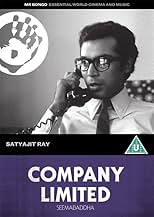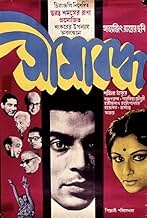Seemabaddha
- 1971
- 1 घं 50 मि
IMDb रेटिंग
7.8/10
1.5 हज़ार
आपकी रेटिंग
चटर्जी एक महत्वाकांक्षी और स्व-निर्मित युवक है जो उस कंपनी का निदेशक बन जाता है जिसके लिए वह काम करता है.चटर्जी एक महत्वाकांक्षी और स्व-निर्मित युवक है जो उस कंपनी का निदेशक बन जाता है जिसके लिए वह काम करता है.चटर्जी एक महत्वाकांक्षी और स्व-निर्मित युवक है जो उस कंपनी का निदेशक बन जाता है जिसके लिए वह काम करता है.
- पुरस्कार
- कुल 2 जीत
फ़ीचर्ड समीक्षाएं
This is a good movie, but not one of Ray's best. The acting is pretty good by the main leads and it has a good story; however it loses something in the execution. The direction does not involve the audience and keeps them at a distance.
Its the story of the rapid rise of an educated and street smart person, up the corporate ladder of a successful Britain-based multinational company; and his experience in that position. This is juxtaposed with his personal life. The film concentrates most of its running time with the character's family.
The movie starts with a prologue which provides us with an information overload and forces us to pay attention from the very first minute. This information is essential as the entire movie revolves around it. However the story does not lose anything if people are unable to grasp all the information thrown at them within the first 5 minutes. The story flows smoothly however a key element in the story is not made clear which makes the ending seem pretty melodramatic which it isn't and had this element been conveyed properly, the end would make complete sense. Nevertheless, the Angel DVD's summary of the film clarifies this aspect which is unfortunate and shows a lack of direction from Ray.
This movie should be considered as supplementary to the other and much better Ray films: Jana Aranya (The Middleman) and Mahanagar (The Big City) which also deal with the corporate world and its effect on people's personal lives.
In the end the movie does not leave us very impressed, but hard core Ray fans will watch it anyways. Five stars for a good story, cinematography and the acting.
Its the story of the rapid rise of an educated and street smart person, up the corporate ladder of a successful Britain-based multinational company; and his experience in that position. This is juxtaposed with his personal life. The film concentrates most of its running time with the character's family.
The movie starts with a prologue which provides us with an information overload and forces us to pay attention from the very first minute. This information is essential as the entire movie revolves around it. However the story does not lose anything if people are unable to grasp all the information thrown at them within the first 5 minutes. The story flows smoothly however a key element in the story is not made clear which makes the ending seem pretty melodramatic which it isn't and had this element been conveyed properly, the end would make complete sense. Nevertheless, the Angel DVD's summary of the film clarifies this aspect which is unfortunate and shows a lack of direction from Ray.
This movie should be considered as supplementary to the other and much better Ray films: Jana Aranya (The Middleman) and Mahanagar (The Big City) which also deal with the corporate world and its effect on people's personal lives.
In the end the movie does not leave us very impressed, but hard core Ray fans will watch it anyways. Five stars for a good story, cinematography and the acting.
The movie was made in the 1970s, amazing to see how much of it still holds true and is relevant in the modern world. Kolkata (and other big cities) is still mostly the same and the rat race shown is even more severe in every field of life today. People like Shyamalendu are battling it out, trying to fit in, not realizing when they are changing ..hard to blame them also, as if not them, somebody else will do the same thing, taking their position. Makes one question as what we really mean by success. The actors did an amazing job, and what can one say about the master's direction. I wish more such films were made today capturing the state of today's society in Bengal..in India.
While thematically Seemabaddha is similar to Jana Aranya, the dramatic element comes only near the end of the film. Instead it plays more like a slice of life film.
I have seen a lot of bollywood movies, they have never been able to give me insight into India as Satyajit Ray's movies have. That is why Seemabaddha was a revelation for me, mostly how little some things have changed.
Seemabaddha begins with visit of Tutul who is sister-in-law of Shyamalendu Chatterjee, movie's protagonist who is a sales manager in a big firm. From then on it mostly shows their daily lives as seen through eyes of Tutul, who is quite critical of her brother-in-law and liked him more when he was teaching. Tutul represent the traditional middle class India, while Shyamlendu is part of upwardly mobile young India. It is about the conflict in both their values. Of course like in most of Ray's movies everything is very subtle, and viewers have to come to their own conclusions.
While it lacks the dramatic elements of most of his high other movies I still loved this movie as it showed me a picture of India I had not seen before.
I have seen a lot of bollywood movies, they have never been able to give me insight into India as Satyajit Ray's movies have. That is why Seemabaddha was a revelation for me, mostly how little some things have changed.
Seemabaddha begins with visit of Tutul who is sister-in-law of Shyamalendu Chatterjee, movie's protagonist who is a sales manager in a big firm. From then on it mostly shows their daily lives as seen through eyes of Tutul, who is quite critical of her brother-in-law and liked him more when he was teaching. Tutul represent the traditional middle class India, while Shyamlendu is part of upwardly mobile young India. It is about the conflict in both their values. Of course like in most of Ray's movies everything is very subtle, and viewers have to come to their own conclusions.
While it lacks the dramatic elements of most of his high other movies I still loved this movie as it showed me a picture of India I had not seen before.
Smart's a misnomer in offices of social wherewithal keeping records on paper for another day at heroism buttressed by inks on winks and dinks off kinks to keep the smarts smart in contexts declared historical for modernity beating in their cusps. The cusp of edges are depressions in vessels of hegemony challenged to survive in time like calendars do with companies and banks marketing raison détres of yore as choices hard chore brooked not with narratives parading as cultural artefacts peculiarly regional but with professional elan on dark schmooze keeping paperwork for distant fans air conditioning for the last man standing, deliberately, for lack of choices in any further professional manoeuvres at offices taken by those that call dibs on files and folders alien to smart cut trouser hems and locals to kitty parties without a regional licence in turn.
This the the next one, but it tells a story of a very rich, successful young man and the credibility of his acts and decisions from the perspective of his sister in law, who believes him and admires too. Written by Shankar, another novelist with a deeper cut cult following, everything is undercurrent in this film. Extramarital affairs, lobbyism, corporate corruption, flirting and even communism. The recurring thing you will see here is the doubt of a suburban girl, who is empathetic about the underground naxalites, between good and bad about the corporate sectors in the then growing third world country. For the people who always needs a well known reference, a lot of scenes in this movie is like 'American Psycho'. And you will get a significant role of Ms. Shefali, just not a cameo.
क्या आपको पता है
- ट्रिवियाOne of the films of the Calcutta Trilogy, the others being Pratidwandi (1970) and Jana Aranya (1975).
टॉप पसंद
रेटिंग देने के लिए साइन-इन करें और वैयक्तिकृत सुझावों के लिए वॉचलिस्ट करें
विवरण
- रिलीज़ की तारीख़
- कंट्री ऑफ़ ओरिजिन
- आधिकारिक साइट
- भाषा
- इस रूप में भी जाना जाता है
- Company Limited
- फ़िल्माने की जगहें
- IMDbPro पर और कंपनी क्रेडिट देखें
- चलने की अवधि1 घंटा 50 मिनट
इस पेज में योगदान दें
किसी बदलाव का सुझाव दें या अनुपलब्ध कॉन्टेंट जोड़ें


























